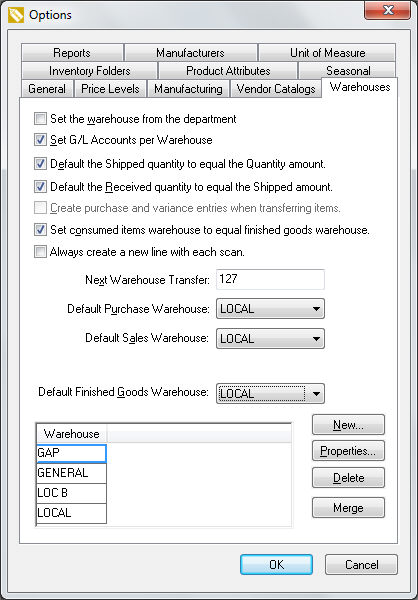Go to to open the following
window:

The Set the warehouse from the department option must be disabled and the Set G/L Accounts per Warehouse must be enabled.
Enable the Default the Shipped quantity to equal the Quantity amount option unless the user enters the products in the inventory transfer list before the transfer step is processed. This option should be enabled in normal situations.
Enable the Default the Received quantity to equal the Shipped amount option if the product is received within the target warehouse at the same time it is shipped from the source warehouse. Review the Using Multiple Locations > Transferring Inventory between Warehouses section for more details.
Disable the Create purchase and variance entries when transferring items option in a normal process. Review the Generate Purchase and Variance Transactions for Warehouse Transfers Option section for more details.
The Set consumed items warehouse to equal finished goods warehouse option is used within the manufacturing window. Review the Manufacturing > Creating a Batch > Multiple Warehouses section within the manufacturing section for more details.
Disable the Always create a new line with each scan option to increment the quantity Shipped instead of creating a new line for each scan. This option only applies when using barcode scanners. Review [Sales] Point of Sale > barcodes > Scanning barcodes sfor more details on scanning barcodes.
The Next Warehouse Transfer number is a sequential number used in the Warehouse Transfer window. Review the Managing Inventory within a Warehouse and Transferring Inventory between Warehouses sections for details on the Warehouse Transfer window.
Click on the New button to add a new warehouse. Review the Create Warehouses section for detailed instructions on creating warehouses.
Enter the Default Purchase Warehouse. The expense invoice and windows will default to this setting.
Set the Default Sales Warehouse that will be used in the sales invoice. This setting is used on the main inventory lookup list. These defaults are user-defined so that each user may select their individual defaults.
Review the Manufacturing > Creating a Batch > Multiple Warehouses section within the for details on the Default Consumed Items Warehouse setting. Click OK to save option settings.
The general ledger accounts are associated with each
warehouse within the inventory item. Open the Advanced
tab of an inventory item as shown below:

The general ledger settings must be set for each warehouse.
Change the Warehouse setting
from the All option to a warehouse
option. The general ledger codes can be set for the selected department
as shown below:
